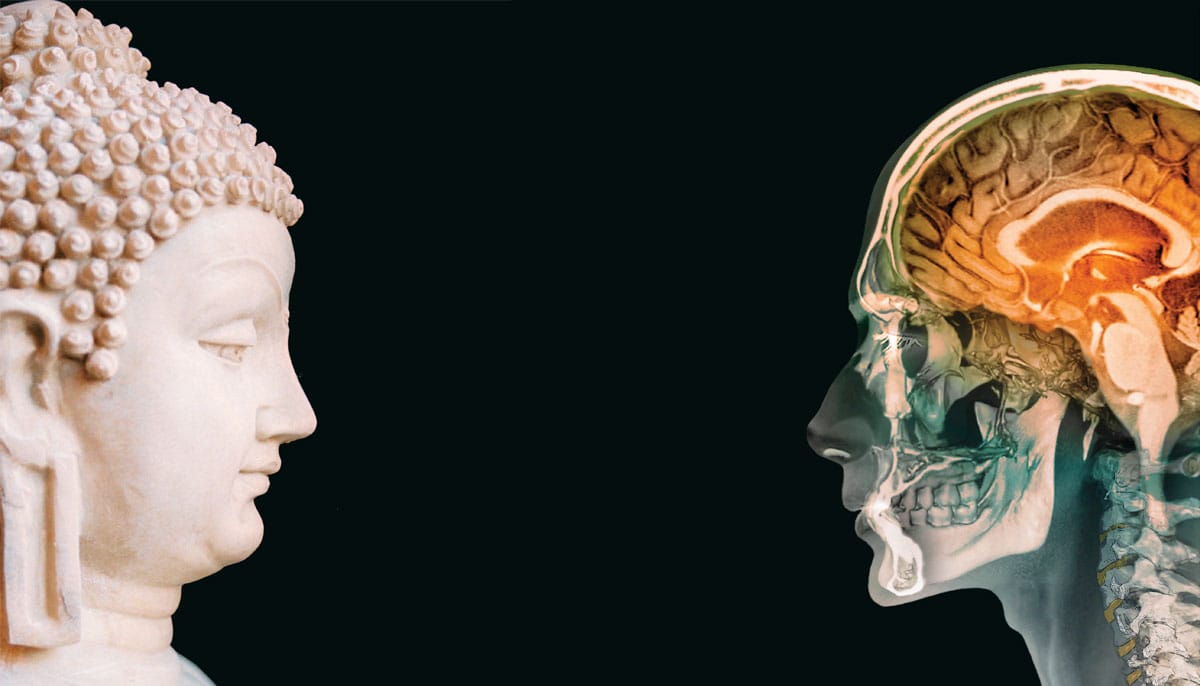The joy of meeting someone you love, the sadness of losing a close friend, the richness of a vivid dream, the serenity of a walk through a garden on a spring day, the total absorption of a deep meditative state—these things and others like them constitute the reality of our experience of consciousness.
Regardless of the content of any one of these experiences, no one in his or her right mind would doubt their reality. Any experience of consciousness—from the most mundane to the most elevated—has a certain coherence and, at the same time, a high degree of privacy, which means that it always exists from a particular point of view. The experience of consciousness is entirely subjective. The paradox, however, is that despite the indubitable reality of our subjectivity and thousands of years of philosophical examination, there is little consensus on what consciousness is. Science, with its characteristic third-person method—the objective perspective from the outside—has made strikingly little headway in this understanding.
The Buddha saw consciousness as playing a key role in determining the course of human happiness and suffering.
The question of consciousness has attracted a good deal of attention in the long history of Buddhist philosophical thinking. For Buddhism, given its primary interest in questions of ethics, spirituality, and overcoming suffering, understanding consciousness, which is thought to be a defining characteristic of sentience, is of great importance. According to the earliest scriptures, the Buddha saw consciousness as playing a key role in determining the course of human happiness and suffering. For example, the famous discourse of the Buddha known as the Dhammapada opens with the statement that mind is primary and pervades all things.
The problem of describing the subjective experiences of consciousness is complex indeed. For we risk objectivizing what is essentially an internal set of experiences and excluding the necessary presence of the experiencer. We cannot remove ourselves from the equation. No scientific description of the neural mechanisms of color discrimination can make one understand what it feels like to perceive, say, the color red. We have a unique case of inquiry: the object of our study is mental, that which examines it is mental, and the very medium by which the study is undertaken is mental. The question is whether the problems posed by this situation for a scientific study of consciousness are insurmountable—are they so damaging as to throw serious doubt on the validity of the inquiry?
Although we tend to relate to the mental world as if it were homogenous—a somewhat monolithic entity called “the mind”— when we probe more deeply, we come to recognize that this approach is too simplistic. As we experience it, consciousness is made up of myriad highly varied and often intense mental states.
There are explicitly cognitive states, like belief, memory, recognition, and attention on the one hand, and explicitly affective states, like the emotions, on the other. In addition, there seems to be a category of mental states that function primarily as causal factors in that they motivate us into action. These include volition, will, desire, fear, and anger. Even within the cognitive states, we can draw distinctions between sensory perceptions, such as visual perception, which has a certain immediacy in relation to the objects being perceived, and conceptual thought processes, such as imagination or the subsequent recollection of a chosen object. These latter processes do not require the immediate presence of the perceived object, nor do they depend upon the active role of the senses.
The question is, What defines this diversity of phenomena as belonging to one family of experience, which we call “mental”? I remember most vividly my first lesson on epistemology as a child, when I had to memorize the dictum “The definition of the mental is that which is luminous and knowing.” It was years later that I realized just how complicated is the philosophical problem hidden behind this simple formulation. Today when I see nine-year-old monks confidently citing this definition of consciousness on the debating floor, which is such a central part of Tibetan monastic education, I smile.
In consciousness, as in light, there is a quality of illumination.
These two features—luminosity, or clarity, and knowing, or cognizance—have come to characterize “the mental” in Indo-Tibetan Buddhist thought. Clarity here refers to the ability of mental states to reveal or reflect. Knowing, by contrast, refers to mental states’ faculty to perceive or apprehend what appears. All phenomena possessed of these qualities count as mental. These features are difficult to conceptualize, but then we are dealing with phenomena that are subjective and internal rather than material objects that may be measured in spatiotemporal terms. Perhaps it is because of these difficulties—the limits of language in dealing with the subjective—that many of the early Buddhist texts explain the nature of consciousness in terms of metaphors such as light or a flowing river. As the primary feature of light is to illuminate, so consciousness is said to illuminate its objects. Just as in light there is no categorical distinction between the illumination and that which illuminates, so in consciousness there is no real difference between the process of knowing, or cognition, and that which knows or cognizes. In consciousness, as in light, there is a quality of illumination.
Western philosophy and science have, on the whole, attempted to understand consciousness solely in terms of the functions of the brain. This approach effectively grounds the nature and existence of the mind in matter, in an ontologically reductionist manner. Some view the brain in terms of a computational model, comparing it to artificial intelligence; others attempt an evolutionary model for the emergence of the various aspects of consciousness. In modern neuroscience, there is a deep question about whether the mind and consciousness are any more than simply operations of the brain, whether sensations and emotions are more than chemical reactions. To what extent does the world of subjective experience depend on the hardware and working order of the brain? It must to some significant extent, but does it do so entirely? What are the necessary and sufficient causes for the emergence of subjective mental experiences?
Many scientists, especially those in the discipline of neurobiology, assume that consciousness is a special kind of physical process that arises through the structure and dynamics of the brain. I vividly remember a discussion I had with some eminent neuroscientists at an American medical school. After they kindly showed me the latest scientific instruments to probe ever deeper into the human brain, such as MRI (magnetic resonance imaging) and EEG (electroencephelograph), and let me view a brain operation in progress (with the family’s permission), we sat down to have a conversation on the current scientific understanding of consciousness. I said to one of the scientists: “It seems very evident that due to changes in the chemical processes of the brain, many of our subjective experiences like perception and sensation occur. Can one envision the reversal of this causal process? Can one postulate that pure thought itself could affect a change in the chemical processes of the brain?” I was asking whether, conceptually at least, we could allow the possibility of both upward and downward causation.
The scientist’s response was quite surprising. He said that since all mental states arise from physical states, it is not possible for downward causation to occur. Although, out of politeness, I did not respond at the time, I thought then and still think that there is as yet no scientific basis for such a categorical claim. The view that all mental processes are necessarily physical processes is a metaphysical assumption, not a scientific fact. I feel that, in the spirit of scientific inquiry, it is critical that we allow the question to remain open, and not conflate our assumptions with empirical fact.
A crucial point about the study of consciousness, as opposed to the study of the physical world, relates to the personal perspective. In examining the physical world, leaving aside the problematic issue of quantum mechanics, we are dealing with phenomena that lend themselves well to the dominant scientific method of the objective, third-person method of inquiry. On the whole, we have a sense that a scientific explanation of the physical world does not exclude the key elements of the field being described. In the realm of subjective experiences, however, the story is completely different. When we listen to a purely third-person, “objective” account of mental states, whether it is a cognitive psychological theory, a neurobiological account, or an evolutionary theory, we feel that a crucial dimension of the subject has been left out. I am referring to the phenomenological aspect of mental phenomena, namely the subjective experience of the individual.
Even from this brief discussion, it is, I think, clear that the third-person method—which has served science so well in so many areas—is inadequate to the explanation of consciousness. What is required, if science is successfully to probe the nature of consciousness, is nothing short of a paradigm shift. That is, the third-person perspective, which can measure phenomena from the point of view of an independent observer, must be integrated with a first-person perspective, which will allow the incorporation of subjectivity and the qualities that characterize the experience of consciousness. I am suggesting the need for the method of our investigation to be appropriate to the object of inquiry. Given that one of the primary characteristics of consciousness is its subjective and experiential nature, any systematic study of it must adopt a method that will give access to the dimensions of subjectivity and experience.
A comprehensive scientific study of consciousness must therefore embrace both third-person and first-person methods: it cannot ignore the phenomenological reality of subjective experience but must observe all the rules of scientific rigor. So the critical question is this: Can we envision a scientific methodology for the study of consciousness whereby a robust first-person method, which does full justice to the phenomenology of experience, can be combined with the objectivist perspective of the study of the brain?
Here I feel a close collaboration between modern science and the contemplative traditions, such as Buddhism, could prove beneficial. Buddhism has a long history of investigation into the nature of mind and its various aspects—this is effectively what Buddhist meditation and its critical analysis constitute. Unlike that of modern science, Buddhism’s approach has been primarily from first-person experience. The contemplative method, as developed by Buddhism, is an empirical use of introspection, sustained by rigorous training in technique and robust testing of the reliability of experience. All meditatively valid subjective experiences must be verifiable both through repetition by the same practitioner and through other individuals being able to attain the same state by the same practice. If they are thus verified, such states may be taken to be universal, at any rate for human beings.

The Buddhist understanding of mind is primarily derived from empirical observations grounded in the phenomenology of experience, which includes the contemplative techniques of meditation. Working models of the mind and its various aspects and functions are generated on this basis; they are then subjected to sustained critical and philosophical analysis and empirical testing through both meditation and mindful observation. If we want to observe how our perceptions work, we may train our mind in attention and learn to observe the rising and falling of perceptual processes on a moment-by-moment basis. This is an empirical process that results in firsthand knowledge of a certain aspect of how the mind works. We may use that knowledge to reduce the effects of emotions such as anger or resentment (indeed, meditation practitioners in search of overcoming mental affliction would wish to do this), but my point here is that this process offers a first-person empirical method with relation to the mind.
Like a trained scientist, a disciplined mind will have the knowledge of what to look for and the ability to recognize when discoveries are made.
What occurs during meditative contemplation in a tradition such as Buddhism and what occurs during introspection in the ordinary sense are two quite different things. In the context of Buddhism, introspection is employed with careful attention to the dangers of extreme subjectivism—such as fantasies and delusions—and with the cultivation of a disciplined state of mind. Refinement of attention, in terms of stability and vividness, is a crucial preparation for the utilization of rigorous introspection, much as a telescope is crucial for the detailed examination of celestial phenomena. Just as in science, there is a series of protocols and procedures that contemplative introspection must employ. Upon entering a laboratory, someone untrained in science would not know what to look at and would have no capacity to recognize when something is found; in the same way, an untrained mind will have no ability to apply the introspective focus on a chosen object and will fail to recognize when processes of the mind show themselves. Just like a trained scientist, a disciplined mind will have the knowledge of what to look for and the ability to recognize when discoveries are made.
It may well be that the question of whether consciousness can ultimately be reduced to physical processes, or whether our subjective experiences are nonmaterial features of the world, will remain a matter of philosophical choice. The key issue here is to bracket out the metaphysical questions about mind and matter, and to explore together how to understand scientifically the various modalities of the mind. I believe that it is possible for Buddhism and modern science to engage in collaborative research in the understanding of consciousness while leaving aside the philosophical question of whether consciousness is ultimately physical. By bringing together these two modes of inquiry, both disciplines may be enriched. Such collaborative study will contribute not only greater human understanding of consciousness but a better understanding of the dynamics of the human mind and its relation to suffering. This is a precious gateway into the alleviation of suffering, which I believe to be our principal task on this earth.
From The Universe in a Single Atom by His Holiness The Dalai Lama, published by Morgan Road Books, a division of Random House, Inc. Reprinted with permission. © 2005 by His Holiness The Dalai Lama.

